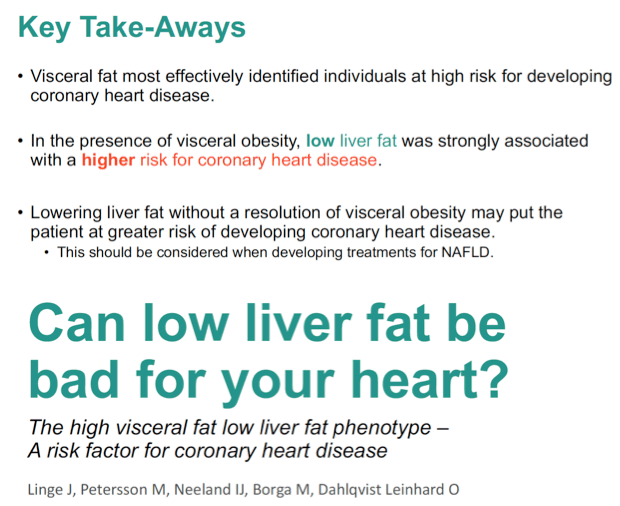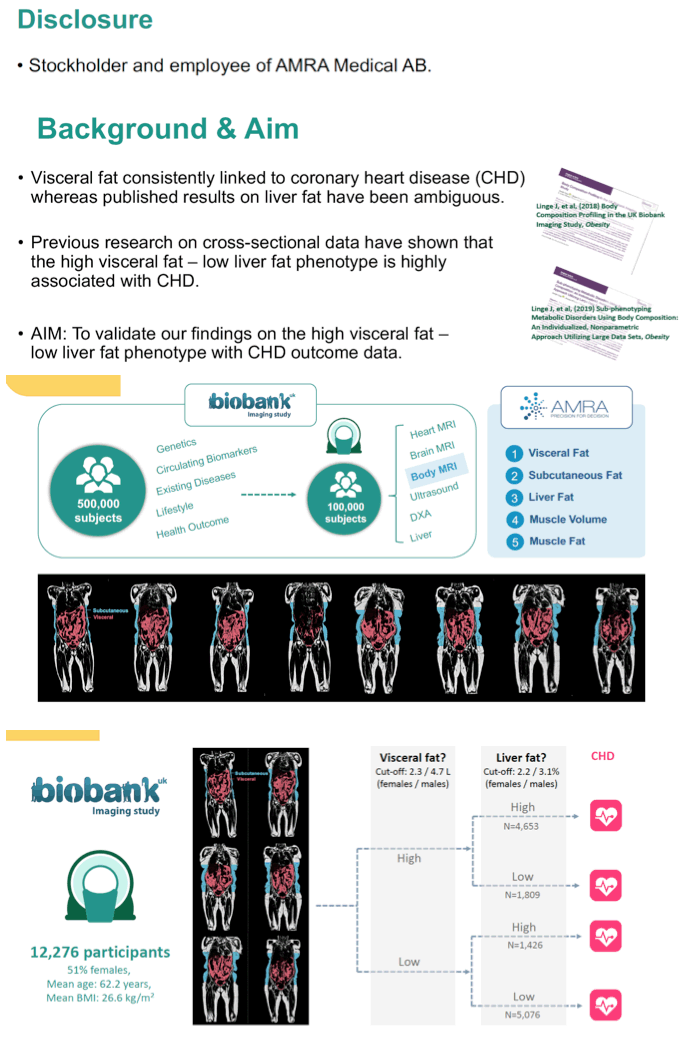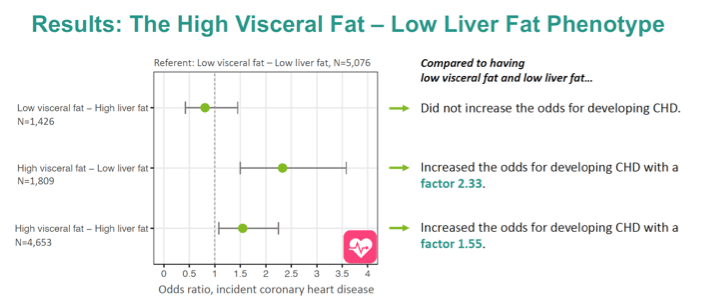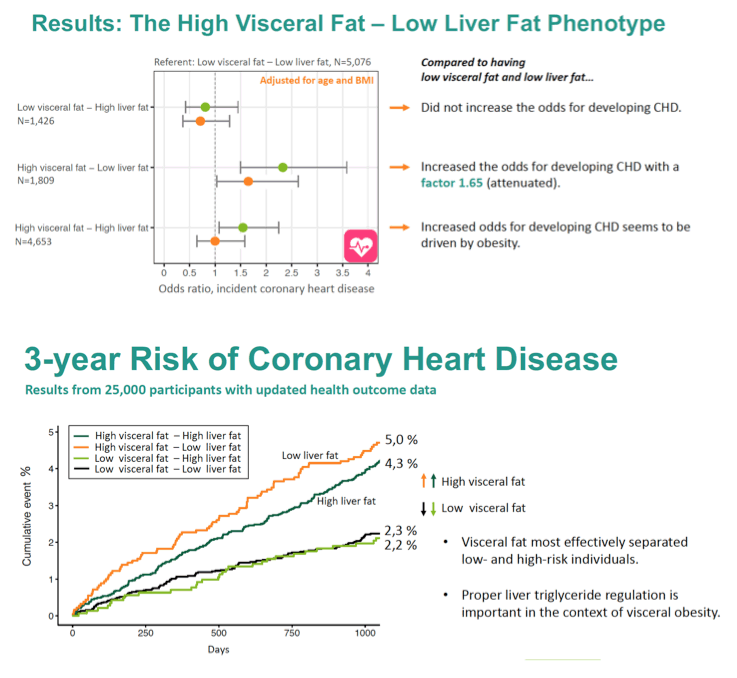 |
 |
 |
| |
Low Liver Fat Tied to Higher CHD Risk in Viscerally Obese People
|
| |
| |
AASLD The Liver Meeting Digital Experience, November 13-16, 2020
Mark Mascolini
Low liver fat in people with high visceral fat raised odds of coronary heart disease (CHD) in a 12,000-person adjusted analysis of the UK Biobank [1]. High visceral fat with high liver fat boosted CHD risk in an unadjusted analyses but not after adjustment for age and body mass index (BMI).
A team from Linkoping University in Sweden noted that research consistently links high visceral fat to greater risk of CHD and other cardiometabolic outcomes. But whether high liver fat has the same impact remains controversial. The Linkoping team conducted this study to analyze the CHD impact of high or low liver fat in people with high visceral fat.
The analysis relied on magnetic resonance imaging (MRI) data on 12,276 people in the UK Biobank. The investigators used AMRA Researcher technology to analyze visceral adipose tissue (VAT) and liver proton density fat fraction (liver fat) and to divide the study group into four phenotypes defined by sex-specific median values for VAT and liver fat. This exercise yielded 4653 people with high VAT and high liver fat, 1809 with high VAT and low liver fat, 1426 with low VAT and high liver fat, and 5076 with low visceral fat and low liver fat (the reference group).
The researchers used logistic regression to explore associations between VAT/liver fat groups and incident (newly diagnosed) CHD identified by ICD-10 codes. A second model adjusted these analyses for age and body mass index.
Women made up just over half of the group, 51%. Age averaged 62.6 years and BMI 26.6 kg/m2. Follow-up continued for an average 1.3 years, during which 176 people got diagnosed with CHD.
CHD incidence stood at 1.6% in the high VAT/high liver fat group, 2.4% in the high VAT/low liver fat group, 0.9% in the low VAT/high liver fat group, and 1.1% in the low VAT/low liver fat group. Compared with the low VAT/low liver fat group, the high VAT/high liver fat group had about 50% higher odds of CHD (odds ratio [OR] 1.55, 95% confidence interval [CI] 1.08 to 2.25, P = 0.018). The high VAT/low liver fat group had more than doubled odds of CHD (OR 2.33, 95% CI 1.50 to 3.58, P < 0.001). Chances of CHD were not higher in the low VAT/high liver fat group than in the low VAT/low liver fat group.
These associations changed after researchers adjusted the analysis for age and BMI. Now high VAT/high liver fat had no impact on CHD risk compared with the low VAT/low liver fat group (adjusted OR [aOR] 1.00, 95% CI 0.64 to 1.58). But high VAT/low liver fat still boosted odds of CHD, about 1.6-fold (aOR 1.65, 95% CI 1.03 to 2.63, P = 0.034). Low VAT/high liver fat still had no impact on odds of CHD compared with the low VAT/low liver fat group (aOR 0.71, 95% CI 0.37 to 1.28).
Analysis of 25,000 Biobank participants with updated health outcome data found a 5.0% 3-year risk of CHD in people with high VAT and low liver fat, a 4.3% risk in those with high VAT and high liver fat, a 2.2% risk in those with low VAT and high liver fat, and a 2.3% risk in those with low VAT and low liver fat.
The Linkoping team proposed that visceral fat most effectively distinguished people with low versus high risk of CHD. But "in the presence of visceral obesity," they stressed, "low liver fat was strongly associated with a higher risk for coronary heart disease." The researchers concluded that decreasing liver fat without addressing visceral obesity may heighten the risk of CHD. They believe researchers should consider these findings when developing therapies for nonalcoholic fatty liver disease (NAFLD).
Reference;
1. Linge J, Petersson M, Neeland I, et al. Can low liver fat be bad for your heart? The high visceral fat, low liver fat phenotype - a risk factor for coronary heart disease. AASLD The Liver Meeting Digital Experience, November 13-16, 2020. Abstract 89.

CAN LOW LIVER FAT BE BAD FOR YOUR HEART? THE HIGH VISCERAL FAT, LOW LIVER FAT PHENOTYPE - A RISK FACTOR FOR CORONARY HEART DISEASE
Jennifer Linge1,2, Mikael Petersson1, Ian Neeland3, Magnus Borga1,4 and Olof Dahlqvist Leinhard1,2, (1)Amra Medical AB, (2)Department of Medical and Health Sciences, Linkoping University, (3)Division of Cardiology, University of Texas Southwestern Medical Center, (4)Department of Biomedical Engineering, Linkoping University
Background: Elevated visceral adipose tissue (VAT) and liver fat (LF) are common in individuals with metabolic disorders such as type 2 diabetes . While excess VAT is consistently linked to cardiometabolic outcomes, associations of LF with cardiometabolic disorders remain controversial . This study aimed to investigate the risk of incident coronary heart disease (CHD) associated with discordant VAT-LF phenotypes in a large population cohort .
Methods: 12,276 individuals from the UK Biobank imaging study were scanned using a 6-minute magnetic resonance imaging (MRI) protocol . Images were analyzed for VAT and liver proton density fat fraction (LF) using AMRA Researcher (AMRA Medical AB, Sweden) . Participants were divided into four phenotype groups defined by sex-specific median values of VAT and LF: low VAT-low LF, low VAT-high LF, high VAT-low LF and high VAT-high LF . Logistic regression was used to assess associations of VAT-LF groups with incident CHD (ICD-10 codes I20-I25, Z951: ischemic heart disease or presence of aortocoronary bypass graft). Odds ratios and 95% confidence intervals were calculated with low VAT-low LF as referent . A second model was adjusted for age and body mass index (BMI) . Results with a p-value < 0.05 were considered significant.
Results: The study cohort consisted of 51% females with a mean (SD) age of 62 .6 (7 .5) years and BMI of 26 .6 (4 .4) kg/ m2 . Participants were followed for a mean (SD) of 1 .3 (0 .8) years . 176 CHD events were recorded following imaging . Sex-specific median values were for VAT 2.3 L and 4.7 L, and LF 2 .2% and 3 .1% (females and males respectively) . High VAT-low LF was most strongly associated with incident CHD with a >2-fold higher odds (Table 1). High LF in the context of low VAT was not associated with increased risk for CHD . After adjustment for age and BMI (Model 2), the association of high VAT-high LF with CHD was attenuated but the association of higher odds for CHD among those with high VAT-low LF persisted .
Conclusion: Heterogeneity of body fat distribution affects CHD risk . There is an increased risk for CHD events among those with high VAT which is enhanced in the context of low LF, indicating that liver triglyceride regulation plays an important role in cardiovascular health in the context of visceral obesity . Further investigations are needed to understand if this phenotype is an expression of an inability to handle ectopic fat deposition via the liver associated with high CHD risk, and if decreased liver fat as consequence of liver dysfunction increases the risk for CHD .



|
| |
|
 |
 |
|
|